Challenges in Managing Global Teams: A Research Project
VerifiedAdded on 2020/03/23
|12
|3256
|412
Project
AI Summary
This project delves into the complexities of managing global teams, a critical aspect of modern business operations. The study begins with an introduction to the concept of global virtual teams, emphasizing the increasing trend of globalization and the need for efficient management strategies. The project's objectives are to understand the concept of global virtual teams, analyze the challenges involved in their management, and investigate potential solutions. The scope of the research is limited to the Australian retail sector, focusing on identifying challenges faced by managers in this context. A comprehensive literature review explores the benefits and challenges of virtual teams, including limitations in physical observation, employee equity issues, and organizational justice concerns. The research employs a quantitative methodology, utilizing a questionnaire survey distributed to industry experts. The data analysis will involve the use of tables, charts, graphs, and MS Excel software to identify key challenges and potential solutions. The project aims to provide valuable insights for managers and leaders, enabling them to develop strategies to enhance the productivity and effectiveness of global teams. The project also addresses the research gap in existing literature, focusing on the specific challenges faced by managers in this context.
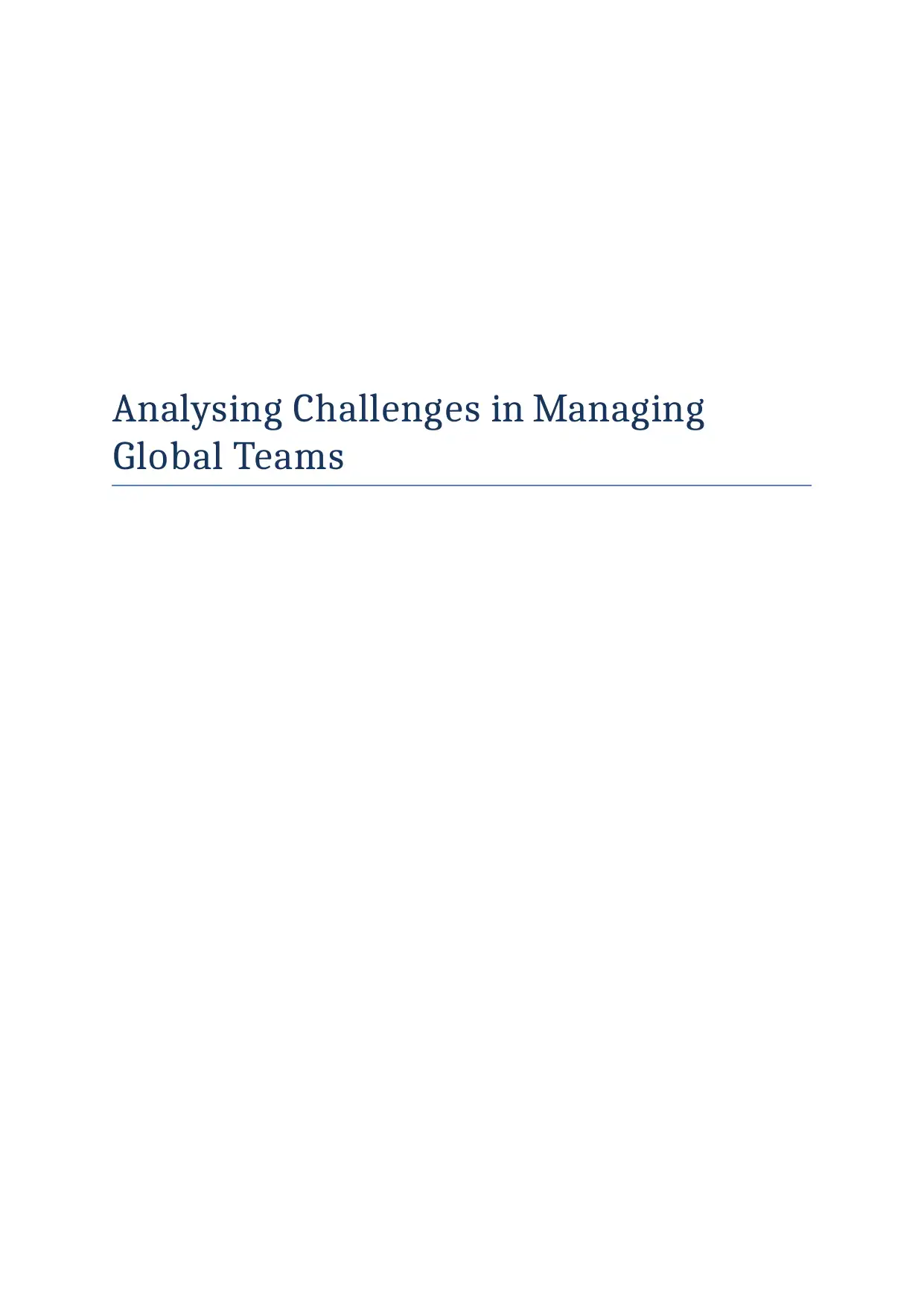
Analysing Challenges in Managing
Global Teams
Global Teams
Paraphrase This Document
Need a fresh take? Get an instant paraphrase of this document with our AI Paraphraser
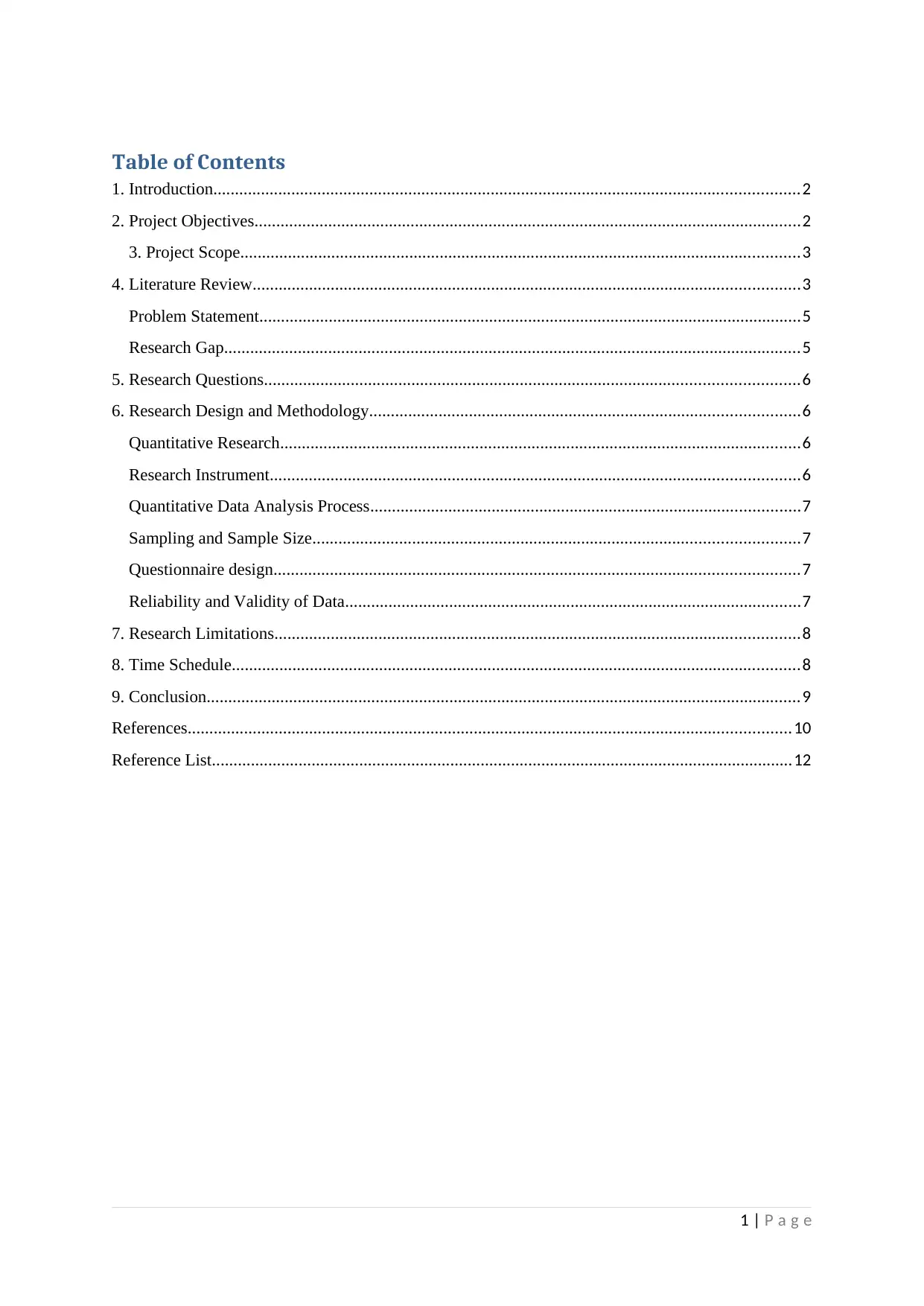
Table of Contents
1. Introduction.......................................................................................................................................2
2. Project Objectives..............................................................................................................................2
3. Project Scope.................................................................................................................................3
4. Literature Review..............................................................................................................................3
Problem Statement.............................................................................................................................5
Research Gap.....................................................................................................................................5
5. Research Questions...........................................................................................................................6
6. Research Design and Methodology...................................................................................................6
Quantitative Research........................................................................................................................6
Research Instrument..........................................................................................................................6
Quantitative Data Analysis Process...................................................................................................7
Sampling and Sample Size................................................................................................................7
Questionnaire design.........................................................................................................................7
Reliability and Validity of Data.........................................................................................................7
7. Research Limitations.........................................................................................................................8
8. Time Schedule...................................................................................................................................8
9. Conclusion.........................................................................................................................................9
References...........................................................................................................................................10
Reference List......................................................................................................................................12
1 | P a g e
1. Introduction.......................................................................................................................................2
2. Project Objectives..............................................................................................................................2
3. Project Scope.................................................................................................................................3
4. Literature Review..............................................................................................................................3
Problem Statement.............................................................................................................................5
Research Gap.....................................................................................................................................5
5. Research Questions...........................................................................................................................6
6. Research Design and Methodology...................................................................................................6
Quantitative Research........................................................................................................................6
Research Instrument..........................................................................................................................6
Quantitative Data Analysis Process...................................................................................................7
Sampling and Sample Size................................................................................................................7
Questionnaire design.........................................................................................................................7
Reliability and Validity of Data.........................................................................................................7
7. Research Limitations.........................................................................................................................8
8. Time Schedule...................................................................................................................................8
9. Conclusion.........................................................................................................................................9
References...........................................................................................................................................10
Reference List......................................................................................................................................12
1 | P a g e
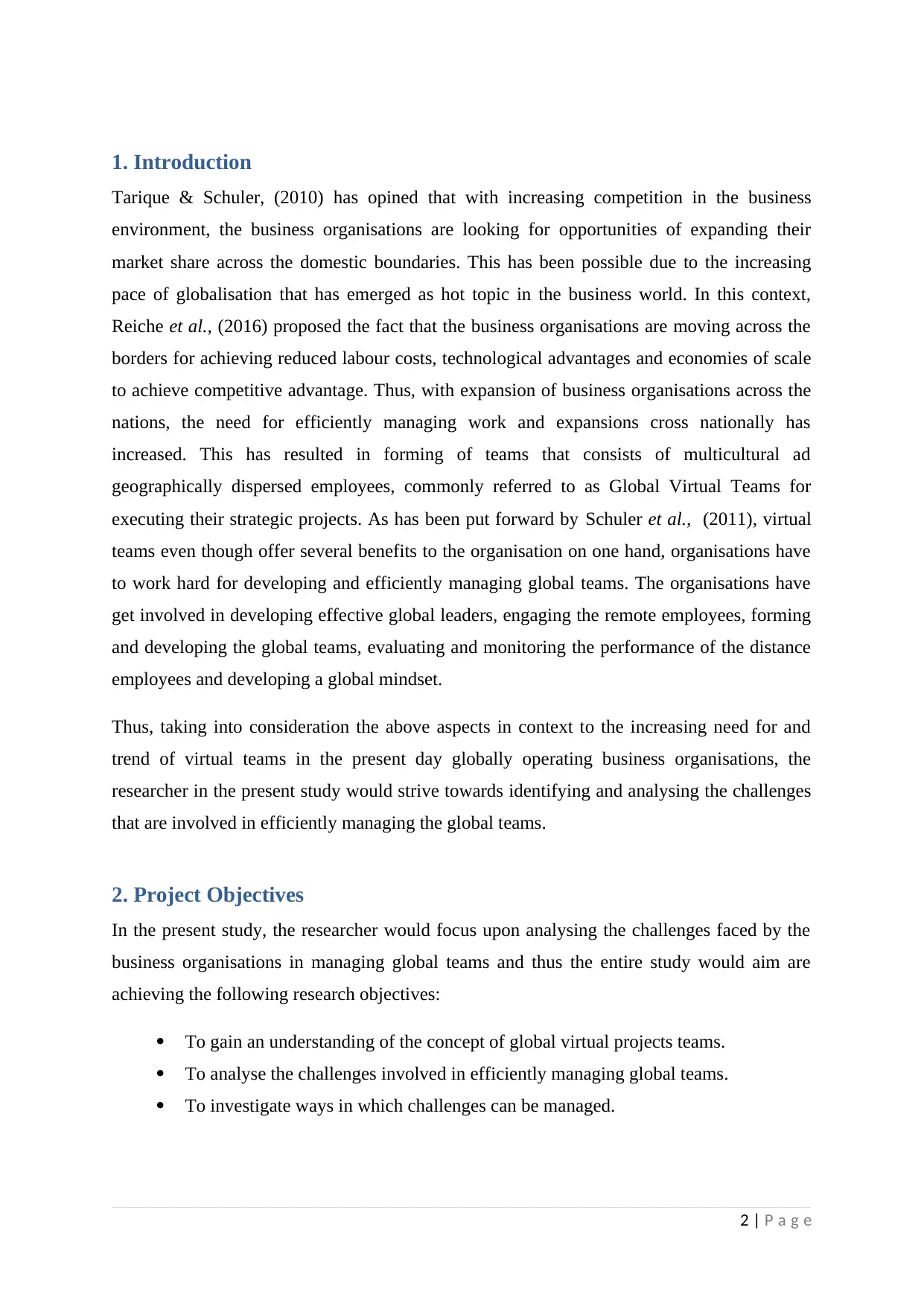
1. Introduction
Tarique & Schuler, (2010) has opined that with increasing competition in the business
environment, the business organisations are looking for opportunities of expanding their
market share across the domestic boundaries. This has been possible due to the increasing
pace of globalisation that has emerged as hot topic in the business world. In this context,
Reiche et al., (2016) proposed the fact that the business organisations are moving across the
borders for achieving reduced labour costs, technological advantages and economies of scale
to achieve competitive advantage. Thus, with expansion of business organisations across the
nations, the need for efficiently managing work and expansions cross nationally has
increased. This has resulted in forming of teams that consists of multicultural ad
geographically dispersed employees, commonly referred to as Global Virtual Teams for
executing their strategic projects. As has been put forward by Schuler et al., (2011), virtual
teams even though offer several benefits to the organisation on one hand, organisations have
to work hard for developing and efficiently managing global teams. The organisations have
get involved in developing effective global leaders, engaging the remote employees, forming
and developing the global teams, evaluating and monitoring the performance of the distance
employees and developing a global mindset.
Thus, taking into consideration the above aspects in context to the increasing need for and
trend of virtual teams in the present day globally operating business organisations, the
researcher in the present study would strive towards identifying and analysing the challenges
that are involved in efficiently managing the global teams.
2. Project Objectives
In the present study, the researcher would focus upon analysing the challenges faced by the
business organisations in managing global teams and thus the entire study would aim are
achieving the following research objectives:
To gain an understanding of the concept of global virtual projects teams.
To analyse the challenges involved in efficiently managing global teams.
To investigate ways in which challenges can be managed.
2 | P a g e
Tarique & Schuler, (2010) has opined that with increasing competition in the business
environment, the business organisations are looking for opportunities of expanding their
market share across the domestic boundaries. This has been possible due to the increasing
pace of globalisation that has emerged as hot topic in the business world. In this context,
Reiche et al., (2016) proposed the fact that the business organisations are moving across the
borders for achieving reduced labour costs, technological advantages and economies of scale
to achieve competitive advantage. Thus, with expansion of business organisations across the
nations, the need for efficiently managing work and expansions cross nationally has
increased. This has resulted in forming of teams that consists of multicultural ad
geographically dispersed employees, commonly referred to as Global Virtual Teams for
executing their strategic projects. As has been put forward by Schuler et al., (2011), virtual
teams even though offer several benefits to the organisation on one hand, organisations have
to work hard for developing and efficiently managing global teams. The organisations have
get involved in developing effective global leaders, engaging the remote employees, forming
and developing the global teams, evaluating and monitoring the performance of the distance
employees and developing a global mindset.
Thus, taking into consideration the above aspects in context to the increasing need for and
trend of virtual teams in the present day globally operating business organisations, the
researcher in the present study would strive towards identifying and analysing the challenges
that are involved in efficiently managing the global teams.
2. Project Objectives
In the present study, the researcher would focus upon analysing the challenges faced by the
business organisations in managing global teams and thus the entire study would aim are
achieving the following research objectives:
To gain an understanding of the concept of global virtual projects teams.
To analyse the challenges involved in efficiently managing global teams.
To investigate ways in which challenges can be managed.
2 | P a g e
⊘ This is a preview!⊘
Do you want full access?
Subscribe today to unlock all pages.

Trusted by 1+ million students worldwide
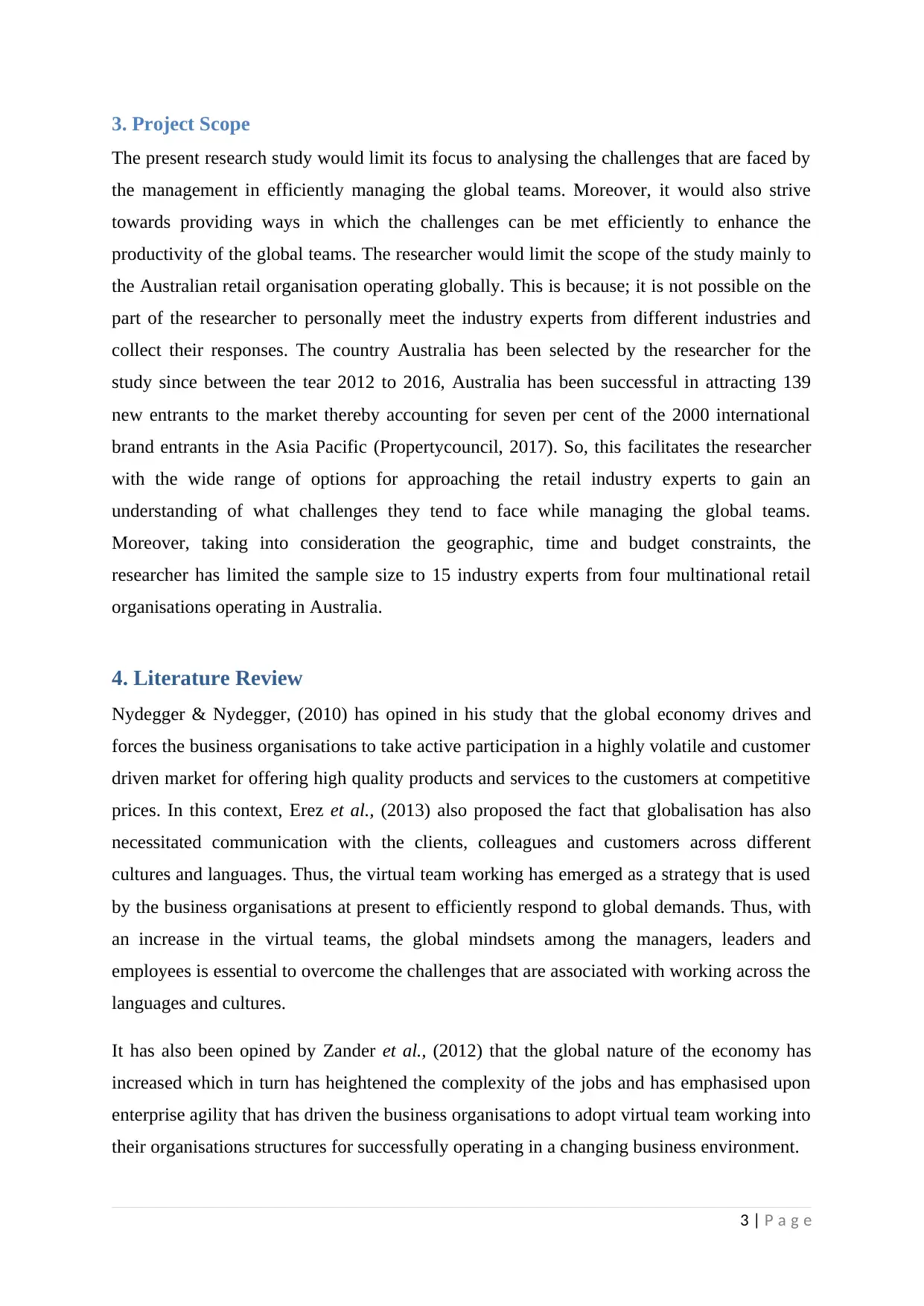
3. Project Scope
The present research study would limit its focus to analysing the challenges that are faced by
the management in efficiently managing the global teams. Moreover, it would also strive
towards providing ways in which the challenges can be met efficiently to enhance the
productivity of the global teams. The researcher would limit the scope of the study mainly to
the Australian retail organisation operating globally. This is because; it is not possible on the
part of the researcher to personally meet the industry experts from different industries and
collect their responses. The country Australia has been selected by the researcher for the
study since between the tear 2012 to 2016, Australia has been successful in attracting 139
new entrants to the market thereby accounting for seven per cent of the 2000 international
brand entrants in the Asia Pacific (Propertycouncil, 2017). So, this facilitates the researcher
with the wide range of options for approaching the retail industry experts to gain an
understanding of what challenges they tend to face while managing the global teams.
Moreover, taking into consideration the geographic, time and budget constraints, the
researcher has limited the sample size to 15 industry experts from four multinational retail
organisations operating in Australia.
4. Literature Review
Nydegger & Nydegger, (2010) has opined in his study that the global economy drives and
forces the business organisations to take active participation in a highly volatile and customer
driven market for offering high quality products and services to the customers at competitive
prices. In this context, Erez et al., (2013) also proposed the fact that globalisation has also
necessitated communication with the clients, colleagues and customers across different
cultures and languages. Thus, the virtual team working has emerged as a strategy that is used
by the business organisations at present to efficiently respond to global demands. Thus, with
an increase in the virtual teams, the global mindsets among the managers, leaders and
employees is essential to overcome the challenges that are associated with working across the
languages and cultures.
It has also been opined by Zander et al., (2012) that the global nature of the economy has
increased which in turn has heightened the complexity of the jobs and has emphasised upon
enterprise agility that has driven the business organisations to adopt virtual team working into
their organisations structures for successfully operating in a changing business environment.
3 | P a g e
The present research study would limit its focus to analysing the challenges that are faced by
the management in efficiently managing the global teams. Moreover, it would also strive
towards providing ways in which the challenges can be met efficiently to enhance the
productivity of the global teams. The researcher would limit the scope of the study mainly to
the Australian retail organisation operating globally. This is because; it is not possible on the
part of the researcher to personally meet the industry experts from different industries and
collect their responses. The country Australia has been selected by the researcher for the
study since between the tear 2012 to 2016, Australia has been successful in attracting 139
new entrants to the market thereby accounting for seven per cent of the 2000 international
brand entrants in the Asia Pacific (Propertycouncil, 2017). So, this facilitates the researcher
with the wide range of options for approaching the retail industry experts to gain an
understanding of what challenges they tend to face while managing the global teams.
Moreover, taking into consideration the geographic, time and budget constraints, the
researcher has limited the sample size to 15 industry experts from four multinational retail
organisations operating in Australia.
4. Literature Review
Nydegger & Nydegger, (2010) has opined in his study that the global economy drives and
forces the business organisations to take active participation in a highly volatile and customer
driven market for offering high quality products and services to the customers at competitive
prices. In this context, Erez et al., (2013) also proposed the fact that globalisation has also
necessitated communication with the clients, colleagues and customers across different
cultures and languages. Thus, the virtual team working has emerged as a strategy that is used
by the business organisations at present to efficiently respond to global demands. Thus, with
an increase in the virtual teams, the global mindsets among the managers, leaders and
employees is essential to overcome the challenges that are associated with working across the
languages and cultures.
It has also been opined by Zander et al., (2012) that the global nature of the economy has
increased which in turn has heightened the complexity of the jobs and has emphasised upon
enterprise agility that has driven the business organisations to adopt virtual team working into
their organisations structures for successfully operating in a changing business environment.
3 | P a g e
Paraphrase This Document
Need a fresh take? Get an instant paraphrase of this document with our AI Paraphraser
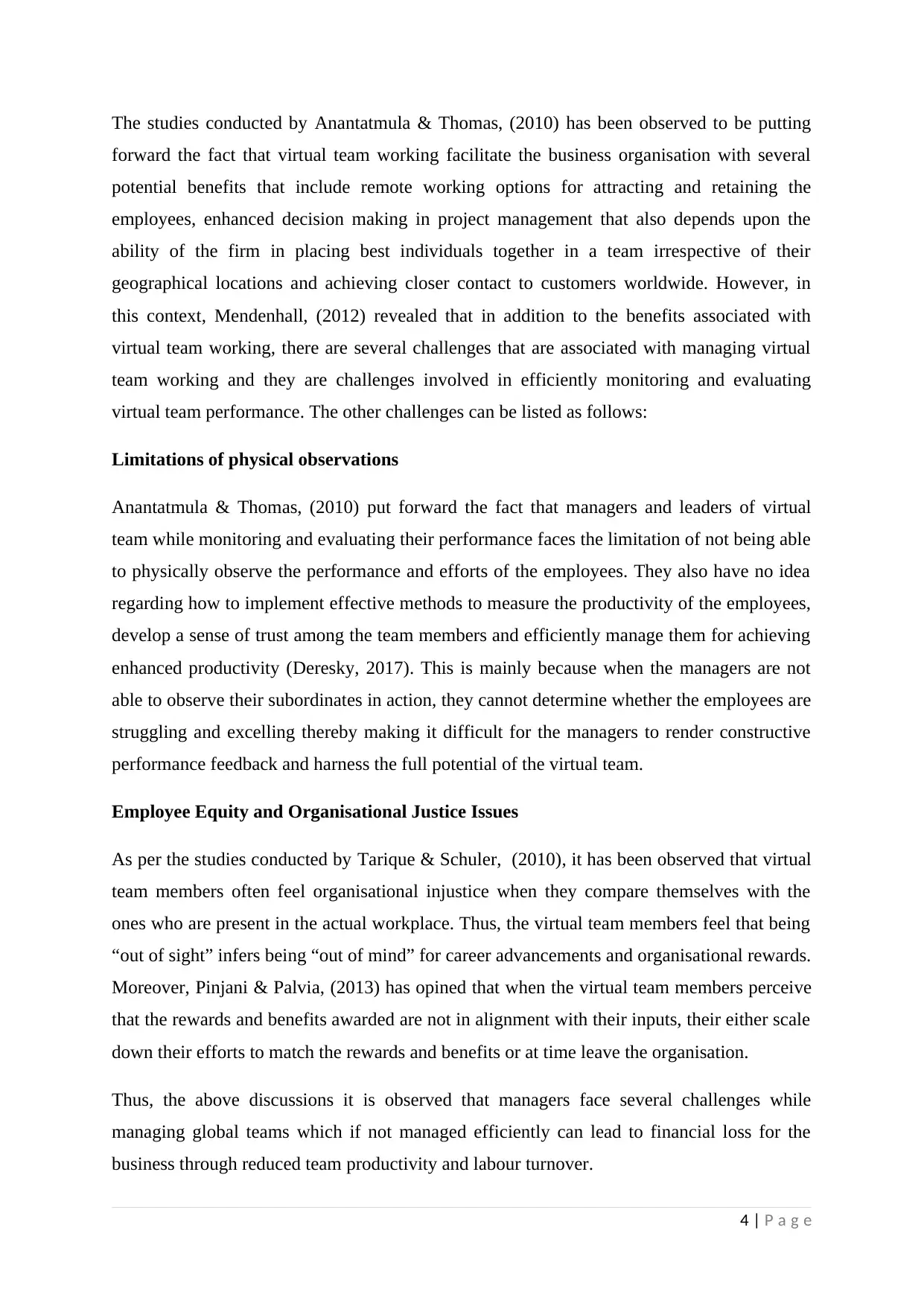
The studies conducted by Anantatmula & Thomas, (2010) has been observed to be putting
forward the fact that virtual team working facilitate the business organisation with several
potential benefits that include remote working options for attracting and retaining the
employees, enhanced decision making in project management that also depends upon the
ability of the firm in placing best individuals together in a team irrespective of their
geographical locations and achieving closer contact to customers worldwide. However, in
this context, Mendenhall, (2012) revealed that in addition to the benefits associated with
virtual team working, there are several challenges that are associated with managing virtual
team working and they are challenges involved in efficiently monitoring and evaluating
virtual team performance. The other challenges can be listed as follows:
Limitations of physical observations
Anantatmula & Thomas, (2010) put forward the fact that managers and leaders of virtual
team while monitoring and evaluating their performance faces the limitation of not being able
to physically observe the performance and efforts of the employees. They also have no idea
regarding how to implement effective methods to measure the productivity of the employees,
develop a sense of trust among the team members and efficiently manage them for achieving
enhanced productivity (Deresky, 2017). This is mainly because when the managers are not
able to observe their subordinates in action, they cannot determine whether the employees are
struggling and excelling thereby making it difficult for the managers to render constructive
performance feedback and harness the full potential of the virtual team.
Employee Equity and Organisational Justice Issues
As per the studies conducted by Tarique & Schuler, (2010), it has been observed that virtual
team members often feel organisational injustice when they compare themselves with the
ones who are present in the actual workplace. Thus, the virtual team members feel that being
“out of sight” infers being “out of mind” for career advancements and organisational rewards.
Moreover, Pinjani & Palvia, (2013) has opined that when the virtual team members perceive
that the rewards and benefits awarded are not in alignment with their inputs, their either scale
down their efforts to match the rewards and benefits or at time leave the organisation.
Thus, the above discussions it is observed that managers face several challenges while
managing global teams which if not managed efficiently can lead to financial loss for the
business through reduced team productivity and labour turnover.
4 | P a g e
forward the fact that virtual team working facilitate the business organisation with several
potential benefits that include remote working options for attracting and retaining the
employees, enhanced decision making in project management that also depends upon the
ability of the firm in placing best individuals together in a team irrespective of their
geographical locations and achieving closer contact to customers worldwide. However, in
this context, Mendenhall, (2012) revealed that in addition to the benefits associated with
virtual team working, there are several challenges that are associated with managing virtual
team working and they are challenges involved in efficiently monitoring and evaluating
virtual team performance. The other challenges can be listed as follows:
Limitations of physical observations
Anantatmula & Thomas, (2010) put forward the fact that managers and leaders of virtual
team while monitoring and evaluating their performance faces the limitation of not being able
to physically observe the performance and efforts of the employees. They also have no idea
regarding how to implement effective methods to measure the productivity of the employees,
develop a sense of trust among the team members and efficiently manage them for achieving
enhanced productivity (Deresky, 2017). This is mainly because when the managers are not
able to observe their subordinates in action, they cannot determine whether the employees are
struggling and excelling thereby making it difficult for the managers to render constructive
performance feedback and harness the full potential of the virtual team.
Employee Equity and Organisational Justice Issues
As per the studies conducted by Tarique & Schuler, (2010), it has been observed that virtual
team members often feel organisational injustice when they compare themselves with the
ones who are present in the actual workplace. Thus, the virtual team members feel that being
“out of sight” infers being “out of mind” for career advancements and organisational rewards.
Moreover, Pinjani & Palvia, (2013) has opined that when the virtual team members perceive
that the rewards and benefits awarded are not in alignment with their inputs, their either scale
down their efforts to match the rewards and benefits or at time leave the organisation.
Thus, the above discussions it is observed that managers face several challenges while
managing global teams which if not managed efficiently can lead to financial loss for the
business through reduced team productivity and labour turnover.
4 | P a g e
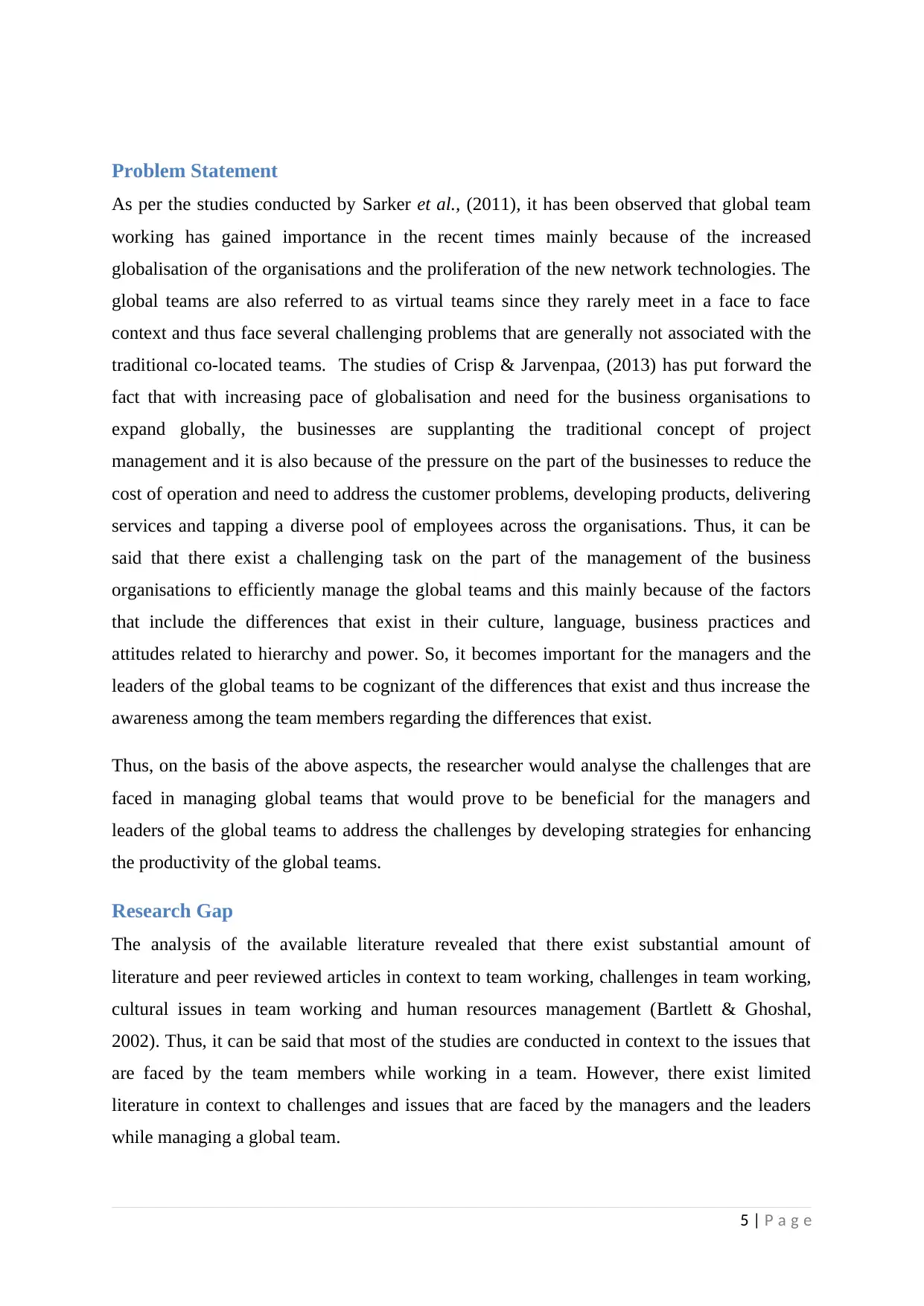
Problem Statement
As per the studies conducted by Sarker et al., (2011), it has been observed that global team
working has gained importance in the recent times mainly because of the increased
globalisation of the organisations and the proliferation of the new network technologies. The
global teams are also referred to as virtual teams since they rarely meet in a face to face
context and thus face several challenging problems that are generally not associated with the
traditional co-located teams. The studies of Crisp & Jarvenpaa, (2013) has put forward the
fact that with increasing pace of globalisation and need for the business organisations to
expand globally, the businesses are supplanting the traditional concept of project
management and it is also because of the pressure on the part of the businesses to reduce the
cost of operation and need to address the customer problems, developing products, delivering
services and tapping a diverse pool of employees across the organisations. Thus, it can be
said that there exist a challenging task on the part of the management of the business
organisations to efficiently manage the global teams and this mainly because of the factors
that include the differences that exist in their culture, language, business practices and
attitudes related to hierarchy and power. So, it becomes important for the managers and the
leaders of the global teams to be cognizant of the differences that exist and thus increase the
awareness among the team members regarding the differences that exist.
Thus, on the basis of the above aspects, the researcher would analyse the challenges that are
faced in managing global teams that would prove to be beneficial for the managers and
leaders of the global teams to address the challenges by developing strategies for enhancing
the productivity of the global teams.
Research Gap
The analysis of the available literature revealed that there exist substantial amount of
literature and peer reviewed articles in context to team working, challenges in team working,
cultural issues in team working and human resources management (Bartlett & Ghoshal,
2002). Thus, it can be said that most of the studies are conducted in context to the issues that
are faced by the team members while working in a team. However, there exist limited
literature in context to challenges and issues that are faced by the managers and the leaders
while managing a global team.
5 | P a g e
As per the studies conducted by Sarker et al., (2011), it has been observed that global team
working has gained importance in the recent times mainly because of the increased
globalisation of the organisations and the proliferation of the new network technologies. The
global teams are also referred to as virtual teams since they rarely meet in a face to face
context and thus face several challenging problems that are generally not associated with the
traditional co-located teams. The studies of Crisp & Jarvenpaa, (2013) has put forward the
fact that with increasing pace of globalisation and need for the business organisations to
expand globally, the businesses are supplanting the traditional concept of project
management and it is also because of the pressure on the part of the businesses to reduce the
cost of operation and need to address the customer problems, developing products, delivering
services and tapping a diverse pool of employees across the organisations. Thus, it can be
said that there exist a challenging task on the part of the management of the business
organisations to efficiently manage the global teams and this mainly because of the factors
that include the differences that exist in their culture, language, business practices and
attitudes related to hierarchy and power. So, it becomes important for the managers and the
leaders of the global teams to be cognizant of the differences that exist and thus increase the
awareness among the team members regarding the differences that exist.
Thus, on the basis of the above aspects, the researcher would analyse the challenges that are
faced in managing global teams that would prove to be beneficial for the managers and
leaders of the global teams to address the challenges by developing strategies for enhancing
the productivity of the global teams.
Research Gap
The analysis of the available literature revealed that there exist substantial amount of
literature and peer reviewed articles in context to team working, challenges in team working,
cultural issues in team working and human resources management (Bartlett & Ghoshal,
2002). Thus, it can be said that most of the studies are conducted in context to the issues that
are faced by the team members while working in a team. However, there exist limited
literature in context to challenges and issues that are faced by the managers and the leaders
while managing a global team.
5 | P a g e
⊘ This is a preview!⊘
Do you want full access?
Subscribe today to unlock all pages.

Trusted by 1+ million students worldwide
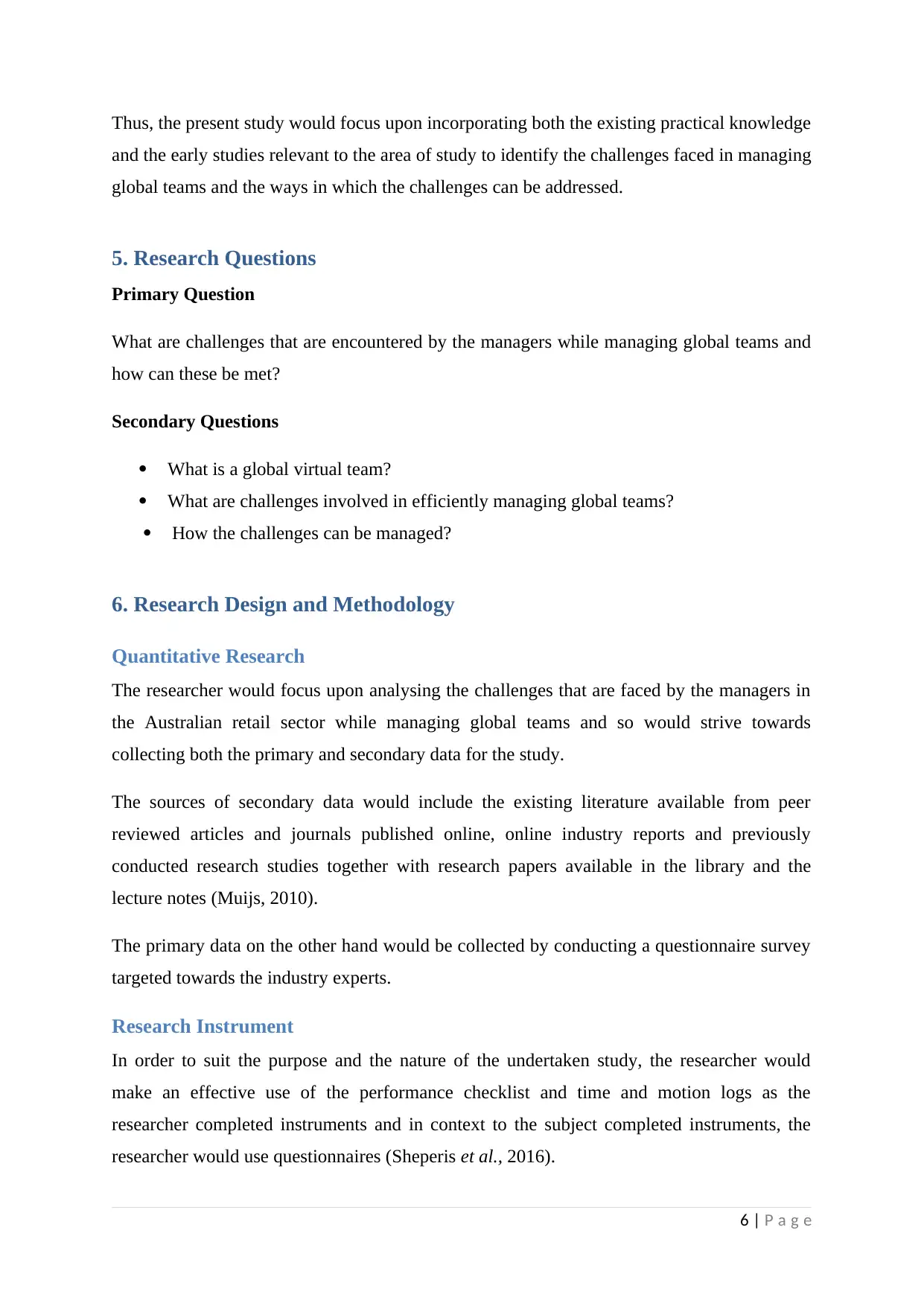
Thus, the present study would focus upon incorporating both the existing practical knowledge
and the early studies relevant to the area of study to identify the challenges faced in managing
global teams and the ways in which the challenges can be addressed.
5. Research Questions
Primary Question
What are challenges that are encountered by the managers while managing global teams and
how can these be met?
Secondary Questions
What is a global virtual team?
What are challenges involved in efficiently managing global teams?
How the challenges can be managed?
6. Research Design and Methodology
Quantitative Research
The researcher would focus upon analysing the challenges that are faced by the managers in
the Australian retail sector while managing global teams and so would strive towards
collecting both the primary and secondary data for the study.
The sources of secondary data would include the existing literature available from peer
reviewed articles and journals published online, online industry reports and previously
conducted research studies together with research papers available in the library and the
lecture notes (Muijs, 2010).
The primary data on the other hand would be collected by conducting a questionnaire survey
targeted towards the industry experts.
Research Instrument
In order to suit the purpose and the nature of the undertaken study, the researcher would
make an effective use of the performance checklist and time and motion logs as the
researcher completed instruments and in context to the subject completed instruments, the
researcher would use questionnaires (Sheperis et al., 2016).
6 | P a g e
and the early studies relevant to the area of study to identify the challenges faced in managing
global teams and the ways in which the challenges can be addressed.
5. Research Questions
Primary Question
What are challenges that are encountered by the managers while managing global teams and
how can these be met?
Secondary Questions
What is a global virtual team?
What are challenges involved in efficiently managing global teams?
How the challenges can be managed?
6. Research Design and Methodology
Quantitative Research
The researcher would focus upon analysing the challenges that are faced by the managers in
the Australian retail sector while managing global teams and so would strive towards
collecting both the primary and secondary data for the study.
The sources of secondary data would include the existing literature available from peer
reviewed articles and journals published online, online industry reports and previously
conducted research studies together with research papers available in the library and the
lecture notes (Muijs, 2010).
The primary data on the other hand would be collected by conducting a questionnaire survey
targeted towards the industry experts.
Research Instrument
In order to suit the purpose and the nature of the undertaken study, the researcher would
make an effective use of the performance checklist and time and motion logs as the
researcher completed instruments and in context to the subject completed instruments, the
researcher would use questionnaires (Sheperis et al., 2016).
6 | P a g e
Paraphrase This Document
Need a fresh take? Get an instant paraphrase of this document with our AI Paraphraser
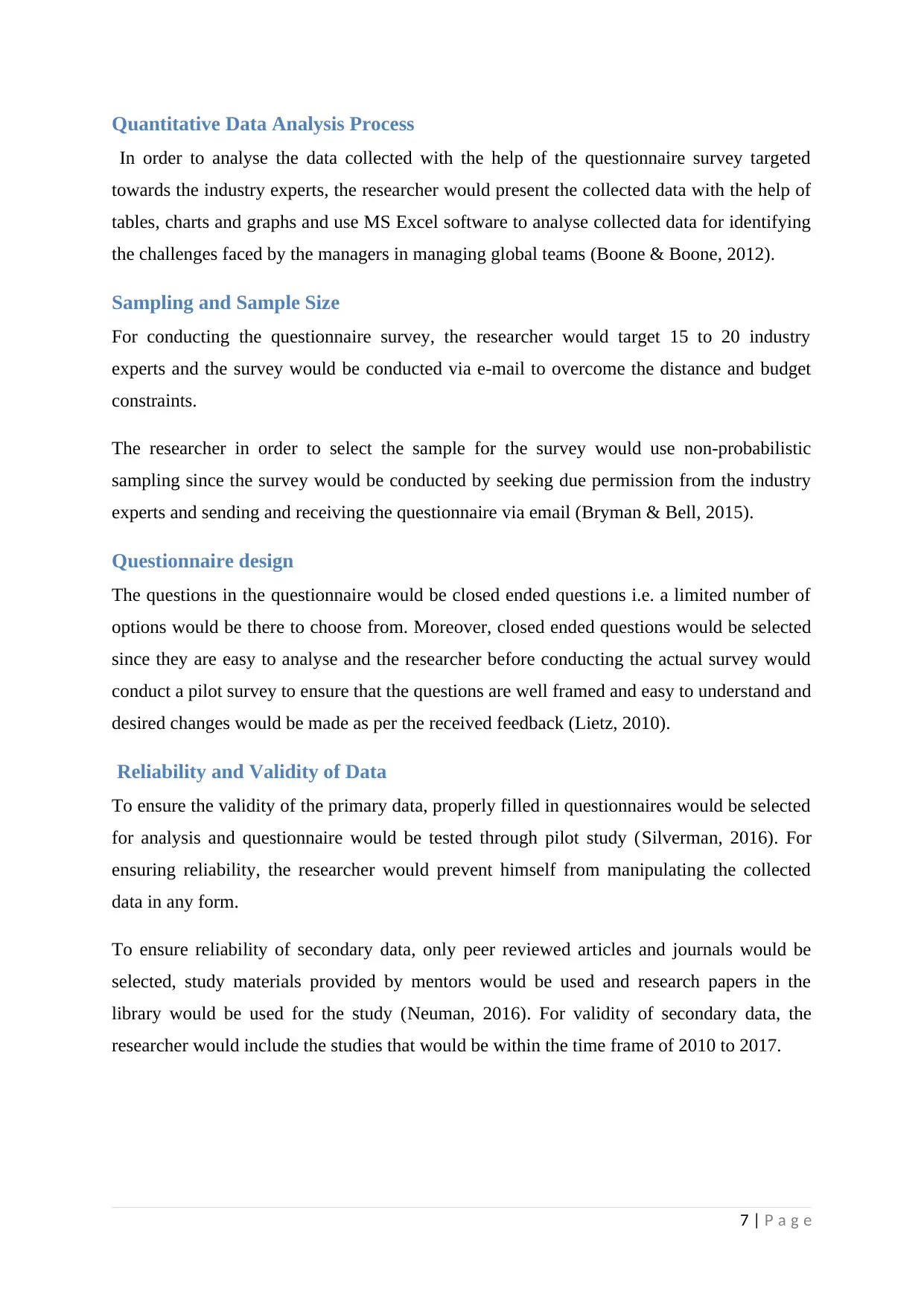
Quantitative Data Analysis Process
In order to analyse the data collected with the help of the questionnaire survey targeted
towards the industry experts, the researcher would present the collected data with the help of
tables, charts and graphs and use MS Excel software to analyse collected data for identifying
the challenges faced by the managers in managing global teams (Boone & Boone, 2012).
Sampling and Sample Size
For conducting the questionnaire survey, the researcher would target 15 to 20 industry
experts and the survey would be conducted via e-mail to overcome the distance and budget
constraints.
The researcher in order to select the sample for the survey would use non-probabilistic
sampling since the survey would be conducted by seeking due permission from the industry
experts and sending and receiving the questionnaire via email (Bryman & Bell, 2015).
Questionnaire design
The questions in the questionnaire would be closed ended questions i.e. a limited number of
options would be there to choose from. Moreover, closed ended questions would be selected
since they are easy to analyse and the researcher before conducting the actual survey would
conduct a pilot survey to ensure that the questions are well framed and easy to understand and
desired changes would be made as per the received feedback (Lietz, 2010).
Reliability and Validity of Data
To ensure the validity of the primary data, properly filled in questionnaires would be selected
for analysis and questionnaire would be tested through pilot study (Silverman, 2016). For
ensuring reliability, the researcher would prevent himself from manipulating the collected
data in any form.
To ensure reliability of secondary data, only peer reviewed articles and journals would be
selected, study materials provided by mentors would be used and research papers in the
library would be used for the study (Neuman, 2016). For validity of secondary data, the
researcher would include the studies that would be within the time frame of 2010 to 2017.
7 | P a g e
In order to analyse the data collected with the help of the questionnaire survey targeted
towards the industry experts, the researcher would present the collected data with the help of
tables, charts and graphs and use MS Excel software to analyse collected data for identifying
the challenges faced by the managers in managing global teams (Boone & Boone, 2012).
Sampling and Sample Size
For conducting the questionnaire survey, the researcher would target 15 to 20 industry
experts and the survey would be conducted via e-mail to overcome the distance and budget
constraints.
The researcher in order to select the sample for the survey would use non-probabilistic
sampling since the survey would be conducted by seeking due permission from the industry
experts and sending and receiving the questionnaire via email (Bryman & Bell, 2015).
Questionnaire design
The questions in the questionnaire would be closed ended questions i.e. a limited number of
options would be there to choose from. Moreover, closed ended questions would be selected
since they are easy to analyse and the researcher before conducting the actual survey would
conduct a pilot survey to ensure that the questions are well framed and easy to understand and
desired changes would be made as per the received feedback (Lietz, 2010).
Reliability and Validity of Data
To ensure the validity of the primary data, properly filled in questionnaires would be selected
for analysis and questionnaire would be tested through pilot study (Silverman, 2016). For
ensuring reliability, the researcher would prevent himself from manipulating the collected
data in any form.
To ensure reliability of secondary data, only peer reviewed articles and journals would be
selected, study materials provided by mentors would be used and research papers in the
library would be used for the study (Neuman, 2016). For validity of secondary data, the
researcher would include the studies that would be within the time frame of 2010 to 2017.
7 | P a g e
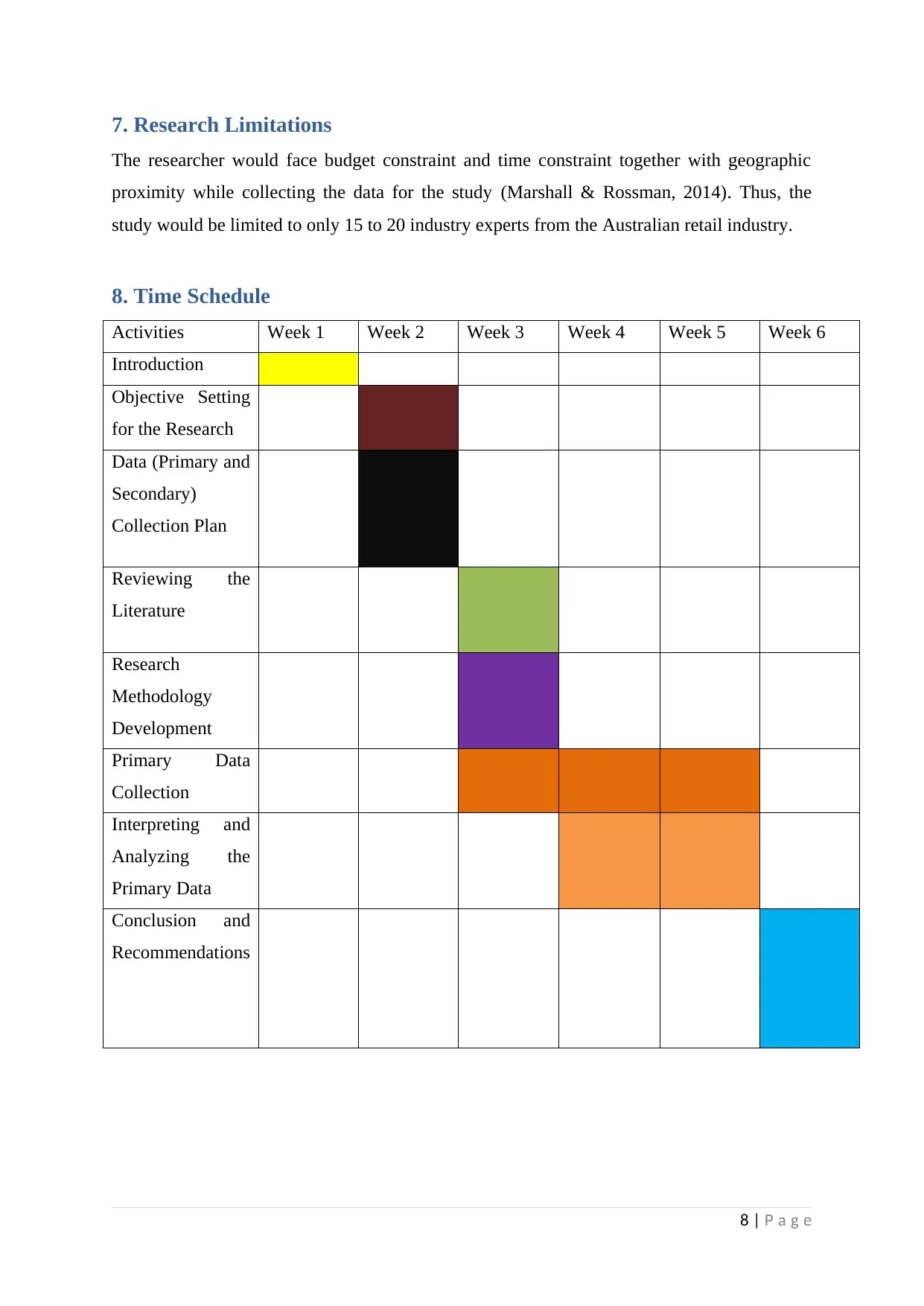
7. Research Limitations
The researcher would face budget constraint and time constraint together with geographic
proximity while collecting the data for the study (Marshall & Rossman, 2014). Thus, the
study would be limited to only 15 to 20 industry experts from the Australian retail industry.
8. Time Schedule
Activities Week 1 Week 2 Week 3 Week 4 Week 5 Week 6
Introduction
Objective Setting
for the Research
Data (Primary and
Secondary)
Collection Plan
Reviewing the
Literature
Research
Methodology
Development
Primary Data
Collection
Interpreting and
Analyzing the
Primary Data
Conclusion and
Recommendations
8 | P a g e
The researcher would face budget constraint and time constraint together with geographic
proximity while collecting the data for the study (Marshall & Rossman, 2014). Thus, the
study would be limited to only 15 to 20 industry experts from the Australian retail industry.
8. Time Schedule
Activities Week 1 Week 2 Week 3 Week 4 Week 5 Week 6
Introduction
Objective Setting
for the Research
Data (Primary and
Secondary)
Collection Plan
Reviewing the
Literature
Research
Methodology
Development
Primary Data
Collection
Interpreting and
Analyzing the
Primary Data
Conclusion and
Recommendations
8 | P a g e
⊘ This is a preview!⊘
Do you want full access?
Subscribe today to unlock all pages.

Trusted by 1+ million students worldwide
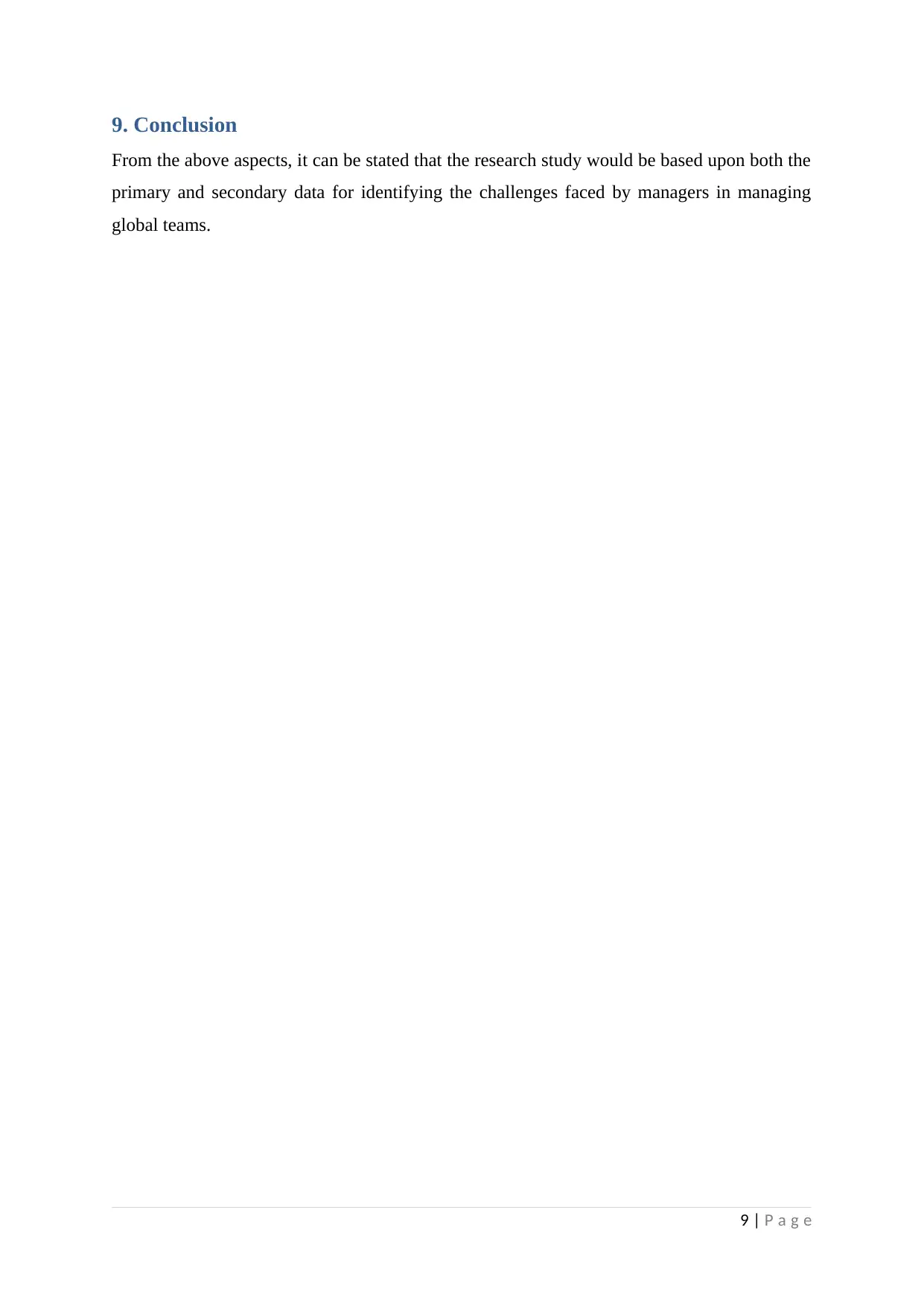
9. Conclusion
From the above aspects, it can be stated that the research study would be based upon both the
primary and secondary data for identifying the challenges faced by managers in managing
global teams.
9 | P a g e
From the above aspects, it can be stated that the research study would be based upon both the
primary and secondary data for identifying the challenges faced by managers in managing
global teams.
9 | P a g e
Paraphrase This Document
Need a fresh take? Get an instant paraphrase of this document with our AI Paraphraser
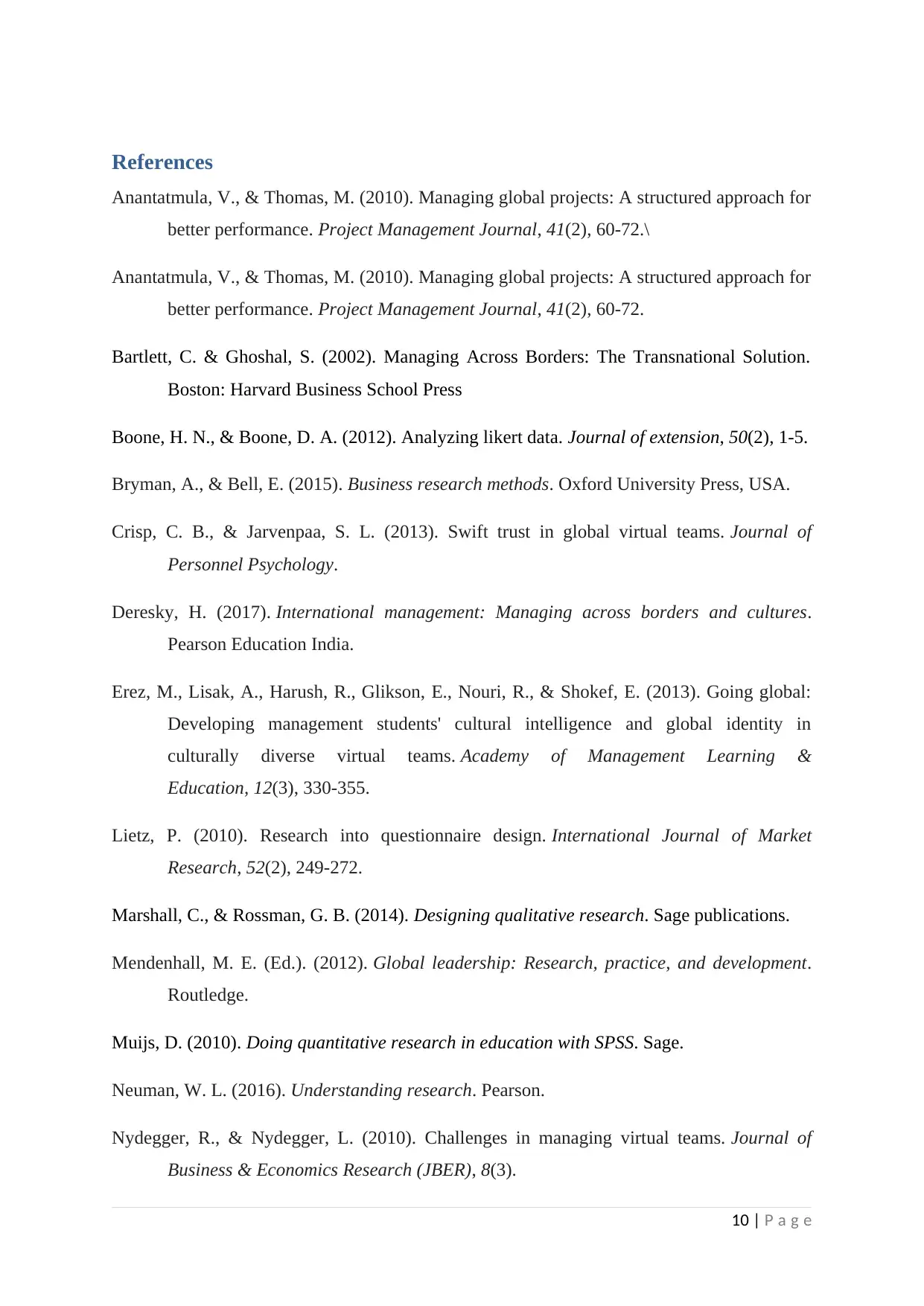
References
Anantatmula, V., & Thomas, M. (2010). Managing global projects: A structured approach for
better performance. Project Management Journal, 41(2), 60-72.\
Anantatmula, V., & Thomas, M. (2010). Managing global projects: A structured approach for
better performance. Project Management Journal, 41(2), 60-72.
Bartlett, C. & Ghoshal, S. (2002). Managing Across Borders: The Transnational Solution.
Boston: Harvard Business School Press
Boone, H. N., & Boone, D. A. (2012). Analyzing likert data. Journal of extension, 50(2), 1-5.
Bryman, A., & Bell, E. (2015). Business research methods. Oxford University Press, USA.
Crisp, C. B., & Jarvenpaa, S. L. (2013). Swift trust in global virtual teams. Journal of
Personnel Psychology.
Deresky, H. (2017). International management: Managing across borders and cultures.
Pearson Education India.
Erez, M., Lisak, A., Harush, R., Glikson, E., Nouri, R., & Shokef, E. (2013). Going global:
Developing management students' cultural intelligence and global identity in
culturally diverse virtual teams. Academy of Management Learning &
Education, 12(3), 330-355.
Lietz, P. (2010). Research into questionnaire design. International Journal of Market
Research, 52(2), 249-272.
Marshall, C., & Rossman, G. B. (2014). Designing qualitative research. Sage publications.
Mendenhall, M. E. (Ed.). (2012). Global leadership: Research, practice, and development.
Routledge.
Muijs, D. (2010). Doing quantitative research in education with SPSS. Sage.
Neuman, W. L. (2016). Understanding research. Pearson.
Nydegger, R., & Nydegger, L. (2010). Challenges in managing virtual teams. Journal of
Business & Economics Research (JBER), 8(3).
10 | P a g e
Anantatmula, V., & Thomas, M. (2010). Managing global projects: A structured approach for
better performance. Project Management Journal, 41(2), 60-72.\
Anantatmula, V., & Thomas, M. (2010). Managing global projects: A structured approach for
better performance. Project Management Journal, 41(2), 60-72.
Bartlett, C. & Ghoshal, S. (2002). Managing Across Borders: The Transnational Solution.
Boston: Harvard Business School Press
Boone, H. N., & Boone, D. A. (2012). Analyzing likert data. Journal of extension, 50(2), 1-5.
Bryman, A., & Bell, E. (2015). Business research methods. Oxford University Press, USA.
Crisp, C. B., & Jarvenpaa, S. L. (2013). Swift trust in global virtual teams. Journal of
Personnel Psychology.
Deresky, H. (2017). International management: Managing across borders and cultures.
Pearson Education India.
Erez, M., Lisak, A., Harush, R., Glikson, E., Nouri, R., & Shokef, E. (2013). Going global:
Developing management students' cultural intelligence and global identity in
culturally diverse virtual teams. Academy of Management Learning &
Education, 12(3), 330-355.
Lietz, P. (2010). Research into questionnaire design. International Journal of Market
Research, 52(2), 249-272.
Marshall, C., & Rossman, G. B. (2014). Designing qualitative research. Sage publications.
Mendenhall, M. E. (Ed.). (2012). Global leadership: Research, practice, and development.
Routledge.
Muijs, D. (2010). Doing quantitative research in education with SPSS. Sage.
Neuman, W. L. (2016). Understanding research. Pearson.
Nydegger, R., & Nydegger, L. (2010). Challenges in managing virtual teams. Journal of
Business & Economics Research (JBER), 8(3).
10 | P a g e
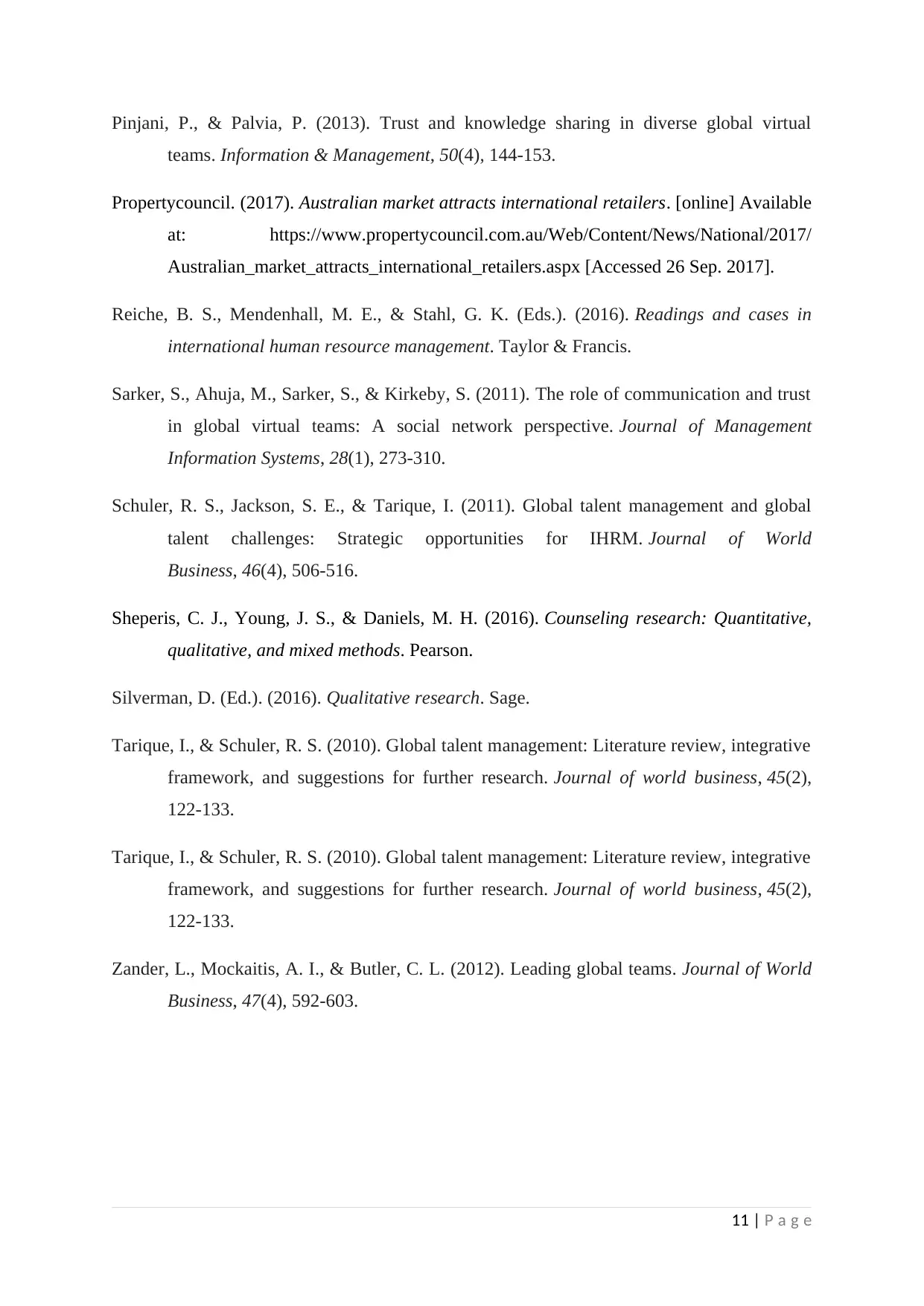
Pinjani, P., & Palvia, P. (2013). Trust and knowledge sharing in diverse global virtual
teams. Information & Management, 50(4), 144-153.
Propertycouncil. (2017). Australian market attracts international retailers. [online] Available
at: https://www.propertycouncil.com.au/Web/Content/News/National/2017/
Australian_market_attracts_international_retailers.aspx [Accessed 26 Sep. 2017].
Reiche, B. S., Mendenhall, M. E., & Stahl, G. K. (Eds.). (2016). Readings and cases in
international human resource management. Taylor & Francis.
Sarker, S., Ahuja, M., Sarker, S., & Kirkeby, S. (2011). The role of communication and trust
in global virtual teams: A social network perspective. Journal of Management
Information Systems, 28(1), 273-310.
Schuler, R. S., Jackson, S. E., & Tarique, I. (2011). Global talent management and global
talent challenges: Strategic opportunities for IHRM. Journal of World
Business, 46(4), 506-516.
Sheperis, C. J., Young, J. S., & Daniels, M. H. (2016). Counseling research: Quantitative,
qualitative, and mixed methods. Pearson.
Silverman, D. (Ed.). (2016). Qualitative research. Sage.
Tarique, I., & Schuler, R. S. (2010). Global talent management: Literature review, integrative
framework, and suggestions for further research. Journal of world business, 45(2),
122-133.
Tarique, I., & Schuler, R. S. (2010). Global talent management: Literature review, integrative
framework, and suggestions for further research. Journal of world business, 45(2),
122-133.
Zander, L., Mockaitis, A. I., & Butler, C. L. (2012). Leading global teams. Journal of World
Business, 47(4), 592-603.
11 | P a g e
teams. Information & Management, 50(4), 144-153.
Propertycouncil. (2017). Australian market attracts international retailers. [online] Available
at: https://www.propertycouncil.com.au/Web/Content/News/National/2017/
Australian_market_attracts_international_retailers.aspx [Accessed 26 Sep. 2017].
Reiche, B. S., Mendenhall, M. E., & Stahl, G. K. (Eds.). (2016). Readings and cases in
international human resource management. Taylor & Francis.
Sarker, S., Ahuja, M., Sarker, S., & Kirkeby, S. (2011). The role of communication and trust
in global virtual teams: A social network perspective. Journal of Management
Information Systems, 28(1), 273-310.
Schuler, R. S., Jackson, S. E., & Tarique, I. (2011). Global talent management and global
talent challenges: Strategic opportunities for IHRM. Journal of World
Business, 46(4), 506-516.
Sheperis, C. J., Young, J. S., & Daniels, M. H. (2016). Counseling research: Quantitative,
qualitative, and mixed methods. Pearson.
Silverman, D. (Ed.). (2016). Qualitative research. Sage.
Tarique, I., & Schuler, R. S. (2010). Global talent management: Literature review, integrative
framework, and suggestions for further research. Journal of world business, 45(2),
122-133.
Tarique, I., & Schuler, R. S. (2010). Global talent management: Literature review, integrative
framework, and suggestions for further research. Journal of world business, 45(2),
122-133.
Zander, L., Mockaitis, A. I., & Butler, C. L. (2012). Leading global teams. Journal of World
Business, 47(4), 592-603.
11 | P a g e
⊘ This is a preview!⊘
Do you want full access?
Subscribe today to unlock all pages.

Trusted by 1+ million students worldwide
1 out of 12
Related Documents
Your All-in-One AI-Powered Toolkit for Academic Success.
+13062052269
info@desklib.com
Available 24*7 on WhatsApp / Email
![[object Object]](/_next/static/media/star-bottom.7253800d.svg)
Unlock your academic potential
Copyright © 2020–2025 A2Z Services. All Rights Reserved. Developed and managed by ZUCOL.




